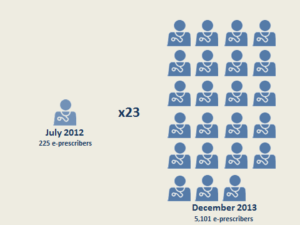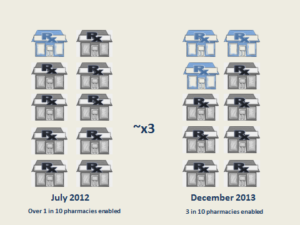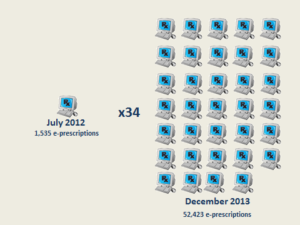
 By Tricia Lee Wilkins, Pharm.D., Ph.D., and
By Tricia Lee Wilkins, Pharm.D., Ph.D., and
Meghan Gabriel, Ph.D. / Economist, Office of Planning, Evaluation, and Analysis
Over the past couple of years, EPCS – the electronic prescribing of controlled substances – has increased dramatically. This has potential benefits for both patients and health care system costs.
Now, thanks to health information technology tools, patients in nearly all 50 states can have their medications prescribed electronically. Electronic prescribing also has the potential to reduce costs to the overall health care system by curbing drug diversions (theft) of controlled substances. According to the HHS Inspector General, the Medicare Prescription Drug Program paid pharmacies $25 million for Schedule II drugs billed as refills in 2009. This was a red flag, the OIG found, because “in no circumstances is Medicare supposed to pay for refills of these drugs.” Using electronic prescribing technology, providers can now also closely track electronic prescriptions of controlled substances through prescription drug monitoring programs (PDMP).
Current estimates show that controlled substances comprise 12 percent of all prescriptions made each year. Because these drugs have potential for abuse, dependence, and overdose, electronic prescribing (e-prescribing) was unavailable until the Drug Enforcement Administration legalized it in 2010. Since then, the number of electronic prescriptions has continued to climb, a benefit to many patients and their health care providers. We co-authored a new study published in the American Journal for Managed Care looking at 18 months of transactional data depicting the EPCS growth in both pharmacies and providers.
 On average, the total number of EPCS increased by nearly 3,000 prescriptions every month during the study period.
On average, the total number of EPCS increased by nearly 3,000 prescriptions every month during the study period.
 We found, on average, the total number of EPCS-enabled pharmacies increased by nearly 700 pharmacies every month. By December 2013, nearly one-third of U.S. pharmacies were enabled to accept EPCS.
We found, on average, the total number of EPCS-enabled pharmacies increased by nearly 700 pharmacies every month. By December 2013, nearly one-third of U.S. pharmacies were enabled to accept EPCS.
 We also found the growth in EPCS among providers (physicians, physician assistants and nurse practitioners) is steadily increasing. In fact, we found that an average of nearly 300 new providers sent EPCS every month.
We also found the growth in EPCS among providers (physicians, physician assistants and nurse practitioners) is steadily increasing. In fact, we found that an average of nearly 300 new providers sent EPCS every month.
However, there are challenges that providers face in using EPCS including system security compliance, provider authentication issues, and regulatory hurdles.
Deaths from drug overdoses have increased 117%. Therefore, addressing opioid use disorder is a high priority for the Department of Health and Human Services. The Department’s goal around opioids is to maximize our ability to deliver impact to the American people through evidence-based strategies that decrease opioid overdoses and overdose-related mortality and decrease the prevalence of opioid use disorder. These include expanded use of PDMPs and integration with health IT systems.
As we move toward better health and health care at lower costs, the growth of EPCS highlights one opportunity to support safer use and management of prescription medications, including controlled substances. As the growth of EPCS continues to increase, we are committed to continue to work with public health officials to address opioid related use and overdose through a variety of programs and coordination efforts.
This post was originally published on the Health IT Buzz and is syndicated here with permission.
